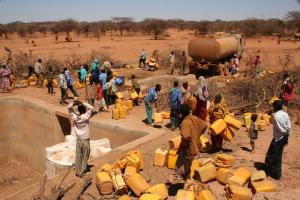Pumping poverty out of Africa
Diffusion of low tech water pumps as a mean to fight food insecurity
09 ott 2015
Francesco Mariotti

Diffusion of low tech water pumps as a mean to fight food insecurityFood security in Africa is negatively affected by uncertain and inadequate rainfall levels. Due to the scarcity of precipitations, land productivity is compromised and a vast amount of farm households suffer from hunger and undernourishment. This represents a serious challenge for farmers' agricultural production.
Incapability to access reliable water sources has been long fought by national governments. However, the implementation of large scale irrigation systems funded by the state has brought fluctuating results. On the contrary, the diffusion of individual and community-owned agricultural water management systems had tremendous effect in increasing farmers' agricultural output and income. A recent study from the International Water Management Institute (IWMI) reports how the diffusion of treadle pumps (TPs) played a crucial role in helping African farmers to cope with rainfall limitations.
Due to their ability to double or triple yields TPs are also known as "money makers" and represent quickly profitable investments for small scale farmers. Successfully adopted in Bangladesh during the 1980's and subsequently introduced in Africa during the following decade, this portable foot operated pump solely counts on human weight to draw water from shallow sources such as wells, lakes or rivers. As a fuel-free irrigation method, TPs also represent a low cost eco-alternative to motorized pumps, mostly accessible to better off farmers.
Starting costs, including installation, range between US$20 and $100 and are easily recoverable within the first harvest season. In this sense IWMI shows how adopters in Mali almost doubled their income passing from $444 to $801 per farm. On the same vein TPs adoption in Burkina Faso increased irrigated areas by 140 percent (IWMI, 2007).
Thanks to the twin cylinders connected to the treadles, TPs are able to lift water in pulses at a continuous rate, thus becoming even more efficient than motorized pumps. TPs can lift up to 7 cubic meters of water per hour from a depth of 7 meters, meeting irrigation needs of most African farmers in 1.75 hour per acre less than traditional methods (IWMI, 2007). Furthermore the possibility be manufactured locally and maintained at minimum cost allow repairs to be made by local technicians, creating job opportunities for the community.
Aside from technical aspects the adoption of TPs opens a window to unprecedented social and market development opportunities. Firstly it allows farmers to grow crops during the dry season. By doing so farmers are not only able to protect their crops from droughts, but also to exploit high offseason market prices and increase their profits. Secondly increased agricultural earnings can support human capital investment, as additional profit is used to fund children education and to access health and sanitary services, which are expected to have additional positive effects on productivity. Lastly TPs allow for crop diversification with major impacts on households diet and enabling them to develop resilience against agricultural commodities price shocks and food insecurity.
Despite the benefits TPS can bring, starting costs still represent a concrete constraint to their adoption, while cultural barriers and their labour intensive costs concur to identify TPs as male gendered oriented technology, since its use is seen as inadequate and excessively arduous for women to undertake.
This said TPs are largely becoming identified to be a suitable and easily adaptable mean for African farmers to escape poverty and get free from rain-fed and obsolete irrigation systems. However coordination among international organization programs, local institutions and farmers' preferences is needed in order to find a constructive solution to grant access to TPs for the remaining non adopters.
Alimentare, Ambiente & Sicurezza, cnr, pumps
